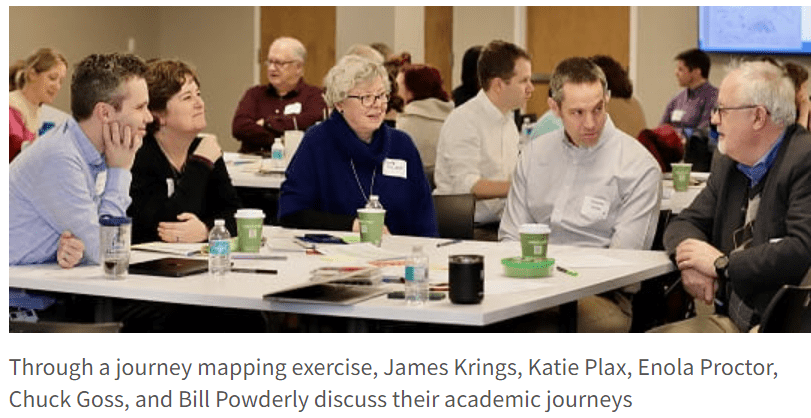By Center for Dissemination & Implementation • February 7, 2024
Written by Vianca Cuevas-Soulette, manager, Implementation Science Center for Cancer Control and Anne Trolard, staff scientist, Center for Dissemination and Implementation
More than 70 students, staff and faculty from across WashU’s implementation science community recently convened for the university’s annual “D&I Day”, held at Delmar Divine. The goal of the daylong event was to build community and shared learning, critically analyze important issues in dissemination and implementation, and to offer tangible steps to create change within implementation science at WashU and eventually, the field.

For participants, D&I Day served as a pivotal moment for collective reflection and strategic planning. A notable highlight was an exercise in which participants mapped their personal journeys through implementation science. The activity shed light on common challenges, such as funding difficulties and Internal Review Board delays, and celebrated D&I Science’s capacity to facilitate the testing and development of interventions in real-life settings. This aspect of the field, where research directly affects practice, was recognized as particularly rewarding.
Some of the main takeaways include:
Navigating the Complexities of Impact Communication
A recurring discussion theme centered on the complexities of communicating impact. Challenges identified in impact communication included setting realistic expectations for the time required to observe tangible impacts, avoiding overpromising, and recognizing the early stages of many D&I initiatives. It was acknowledged that effective impact communication is crucial, and researchers have a responsibility to convey the value of their research to the community, funders, and the public to justify the investment and its broader societal implications.
Enhancing Community Involvement
The discussions underscored the importance of deepening community involvement in research. This involves more than merely seeking participation; it requires ensuring that research efforts offer genuine value to community members, such as compensation for their time. The call for a more inclusive and responsive IRB process was clear, highlighting the need for an IRB process that accommodates and respects the time constraints of all involved parties.
Strengthening Dissemination Efforts
There was a recognized need to enhance the infrastructure supporting the dissemination and communication of impact. This involves not just communicating results but ensuring that these results are communicated as compelling stories. The discussions advocated for providing researchers with the necessary resources to effectively share their discoveries, thereby increasing the visibility and influence of D&I Science on public health policies and practices.

Impact
During D&I day I found myself trying to sort out a few things, including the role of science and evidence when defining impact. I started to think about roles in general – what is the role of a scientist? Once I sort that out, I thought, I can think about what our impact can be.
In our role as scientists we work primarily to contribute to a knowledge base. Our implementation science knowledge base contains a key ingredient of what is needed to ensure the health and well-being of people – our animating purpose. A good knowledge base in our case contains insights and tools available for use; and people other than us – including implementers – can choose to use it, and hopefully our efforts lead to that.
Our science can’t produce outcomes and alone cannot ensure health. I would even say our science cannot and should not try to ensure the uptake of our evidence. To try to ensure that would be doing the implementer’s job. People’s health and well-being is dependent on many factors outside of what the scientific fields of dissemination and implementation can support. But I think a great deal of potential for impact lies in the process of our work: our attention to developing shared language and common meaning with our non-academic partners, sharing findings with participants and stakeholders to provoke discussion, and pushing against historic structures that siloed knowledge creation in the academy. All of these parts of our job create new paths for shared understanding and dialogue. I think researchers have a tremendous opportunity to rebuild trust in science, which is essential infrastructure for health and well-being.